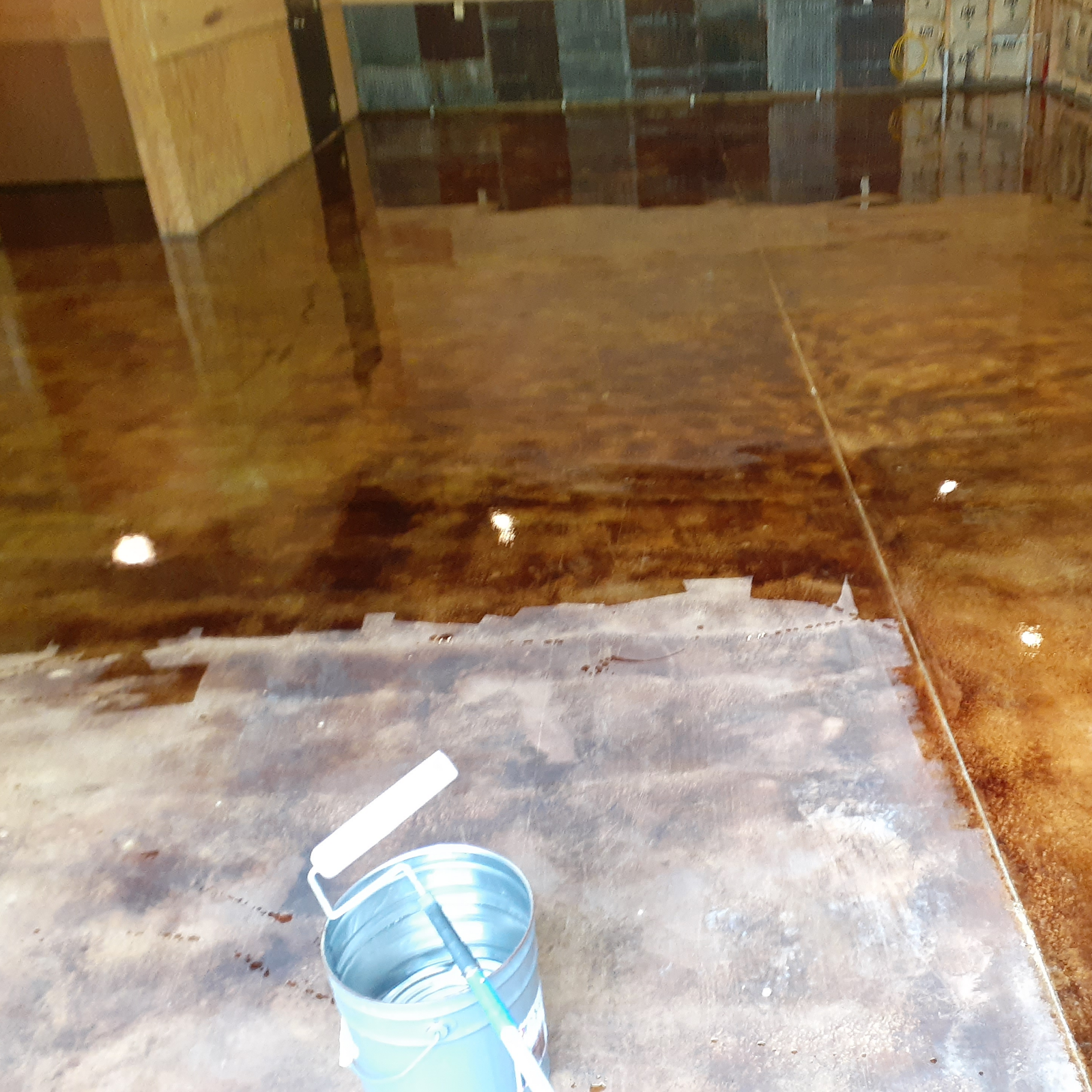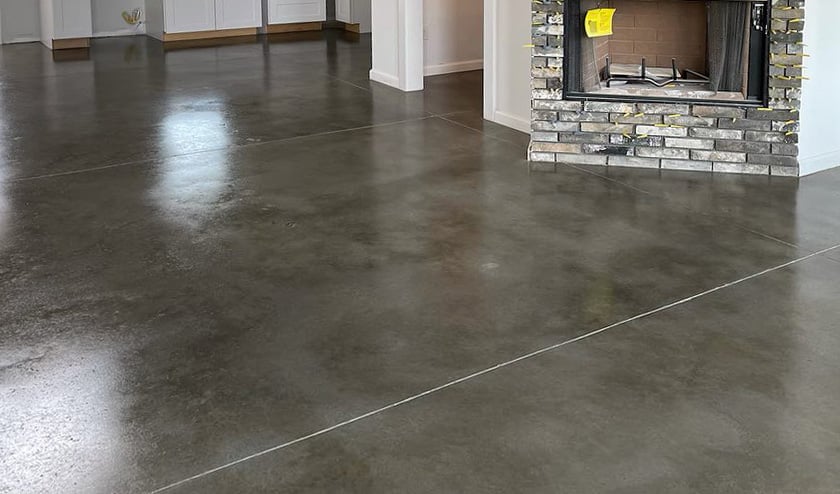Costly pitfalls homeowners make when working with stained concrete contractors
Wiki Article
Everything About Stained Concrete: A Comprehensive Overview to Its Benefits and Applications
Stained concrete has actually become a prominent option for both household and business spaces. Its capability to combine visual charm with practicality makes it a fascinating option. Numerous discoloration techniques provide an array of shades and surfaces, enabling for modification. However, the benefits extend beyond appearance. Comprehending its applications and maintenance needs is important for any individual considering this flexible product. The subtleties of stained concrete welcome further exploration.What Is Stained Concrete?

Staining can be put on various surfaces, including floors, driveways, and outdoor patios, making it a functional alternative for both interior and exterior rooms. The therapy can attain a variety of appearances, from natural tones to bold, modern styles. Unlike paint, stained concrete maintains its appearance over time, as it becomes an important part of the concrete itself. Generally, stained concrete serves as an effective method for changing common concrete right into visually striking surfaces.
Benefits of Stained Concrete
Stained concrete deals considerable advantages, especially in visual allure and longevity - local stained concrete. Its vivid colors and special patterns enhance the aesthetic beauty of any kind of room, making it a popular selection for both household and commercial applications. Furthermore, the longevity of stained concrete guarantees that it stays a practical financial investment with time, standing up to damageVisual Appeal
One of one of the most engaging benefits of using stained concrete is its impressive aesthetic appeal. Stained concrete deals an unique and versatile appearance that can match various layout styles, from contemporary to rustic. The mixture of vivid colors and complex patterns permits house owners and designers to develop customized surface areas that can enhance the total ambiance of a room. Unlike standard flooring choices, stained concrete can simulate the appearance of all-natural rock or polished marble, offering a high end look without the linked costs. Furthermore, the glossy surface alternatives can reflect light, more brightening insides. This adaptability makes stained concrete a preferred option for both residential and business applications, where visual influence is paramount.Durability and Longevity
The impressive aesthetic high qualities of stained concrete are enhanced by its remarkable sturdiness and longevity - stained concrete company. Stained concrete surfaces are immune to damage, making them suitable for high-traffic areas both indoors and outdoors. Their robust nature means they can withstand harsh climate condition, including extreme temperature levels, rain, and UV exposure, without significant destruction. On top of that, stained concrete calls for very little maintenance contrasted to various other floor covering alternatives, as it does not require frequent securing or redecorating. This longevity not just lowers replacement expenses however additionally adds to a sustainable building approach. Generally, stained concrete supplies a long-lasting solution that combines visual charm with functional advantages, ensuring its worth with timeDifferent Sorts Of Staining Techniques
Various discoloration methods can markedly influence the aesthetic high qualities of concrete surface areas. The three main methods include acid staining, which reacts chemically with the concrete, water-based staining, which uses a more comprehensive variety of colors, and overlay discoloration options that provide a fresh surface. Each strategy has distinct attributes and applications that cater to various layout choices and project requirements.
Acid Discoloration Technique
Exactly how can property owners transform ordinary concrete surfaces into visually striking attributes? One effective approach is acid staining, a preferred technique that boosts the natural charm of concrete. This process includes using a service of water, hydrochloric acid, and metal salts to the concrete surface. As the acid reacts with the lime present in the concrete, it develops rich, variegated colors that appear like marble or stone. Acid discoloration is understood for its durability and resistance to fading, making it a resilient option for both interior and exterior applications. It is crucial to note that the results can differ based on the original concrete shade and texture. Appropriate application and securing are important for attaining the wanted aesthetic and durabilityWater-Based Discoloration Strategy
A popular alternative to acid staining, the water-based staining technique supplies homeowners a flexible way to improve concrete surfaces. This method makes use of water-soluble dyes and pigments, enabling a variety of colors and coatings. Unlike acid spots, water-based discolorations can be put on unsealed concrete and use a less complicated cleanup process. The outcomes can accomplish a much more uniform look and can be layered to produce distinct impacts. Additionally, water-based stains are typically much less toxic and give off less unstable organic compounds (VOCs), making them much more environmentally pleasant. House owners might value the capacity to personalize their concrete surface areas with various tones, allowing for imaginative expression while preserving resilience and long life in their floor covering selections.Overlay Staining Options
Numerous overlay discoloration options exist for homeowners aiming to invigorate their concrete surface areas. One popular choice is acid staining, which reacts chemically with the concrete to generate rich, variegated shades. One try this out more choice is water-based staining, providing a broader shade combination and simpler application. In addition, concrete overlays can be integrated with patterns for detailed designs, boosting aesthetic appeals. For a more textured surface, property owners might think about utilizing stamped overlays that simulate natural products like stone or floor tile. Each strategy offers special advantages, from sturdiness to modification, permitting a personalized touch. Inevitably, the option of overlay discoloration depends upon the desired look and the problem of the existing concrete, making sure a freshened and attractive surface area.Applications of Stained Concrete
Stained concrete deals a flexible remedy for different applications, boosting both aesthetic charm click and functionality. This material is frequently used in residential, business, and commercial settings, making it a popular option amongst architects and developers. In homes, stained concrete can offer as trendy flooring or outdoor patios, supplying an innovative appearance while staying long lasting.In industrial spaces, such as stores and dining establishments, stained concrete contributes to a modern atmosphere and can stand up to heavy foot website traffic. In addition, stained concrete is progressively used in public areas like parks and pathways, where its capability to mimic natural rock or various other materials adds visual passion.
Furthermore, stained concrete is perfect for pool decks and driveways, providing a slip-resistant surface area that is simple to preserve. Generally, the flexibility of stained concrete makes it ideal for countless atmospheres, catering to diverse tastes and requirements.
Maintenance and Care for Stained Concrete
Appropriate upkeep guarantees the long life and appeal of stained concrete surfaces. Routine cleaning is vital; using a light cleaning agent and water with a soft-bristle brush aids remove dirt and gunk without harming the coating. It is a good idea to stay clear of harsh chemicals that can remove the stain or sealant.
Securing stained concrete is vital for protection versus wetness, spots, and put on. A high-quality sealant must be reapplied each to 3 years, depending on the traffic and direct exposure the surface area endures. Furthermore, resolving spills immediately will avoid staining and discoloration.

Expense Considerations for Stained Concrete Projects
When planning a tarnished concrete task, spending plan considerations play a vital role in identifying the overall price. The expenses connected with stained concrete can vary significantly based on a number of factors. Initially, the dimension of the area to be stained directly affects product and labor prices. Larger areas will naturally call for more sources. Second, the kind of discolor selected-- acid-based or water-based-- can affect prices, with acid stains typically being extra costly. Furthermore, the complexity of the design, consisting of patterns or multiple shades, can boost labor expenses. Preparation job, such as cleaning and grinding the concrete surface area, contributes to the first expenses too. Finally, the selection between do it yourself setup and employing a specialist contractor will certainly better affect the budget. Understanding these aspects enables homeowners to make enlightened financial choices regarding their stained concrete jobs, guaranteeing they accomplish the desired aesthetic within their economic ways.Tips for Selecting the Right Stained Concrete for Your Area
Selecting the appropriate stained concrete for a details space includes mindful consideration of various variables beyond just spending plan. One need to evaluate the designated usage of the location. High-traffic zones might need even more resilient coatings, while attractive applications can focus on looks.The shade palette is another vital aspect; the selected hues need to integrate with existing style and illumination. It's likewise essential to take into account the surface area structure, as smooth surfaces can boost sophistication, check my source while textured choices might assure security in wet areas.
Local climate and ecological conditions play a substantial duty in the longevity and maintenance of stained concrete, affecting the option of sealers and finishes.
Ultimately, speaking with specialists can provide important understandings customized to particular demands, ensuring the choice of the perfect stained concrete that lines up with both capability and design.

Frequently Asked Concerns
Can Stained Concrete Be Applied Over Existing Flooring?
Stained concrete can undoubtedly be used over existing floor covering, provided the surface is stable and properly prepared. This technique allows for an aesthetic upgrade without the requirement for full elimination of the original flooring products.Exactly How Lengthy Does Stained Concrete Last?
Stained concrete can last for decades when properly kept. Variables such as web traffic, ecological problems, and application methods significantly influence its long life, with numerous installations continuing to be dynamic and undamaged for 10 to 30 years.Is Stained Concrete Slippery When Wet?
Stained concrete can be slippery when wet, as the finish might produce a smooth surface area. Nevertheless, using non-slip additives or textured finishes can minimize this concern, improving safety and security without jeopardizing the aesthetic charm of the concrete.Can I Discolor Concrete Myself, or Should I Work with a Specialist?
The decision to tarnish concrete personally or work with an expert rest on skill level and project complexity. While DIY staining can save money, professionals guarantee suitable outcomes, especially for complex designs or huge surface areas.What Colors Are Available for Stained Concrete?
The range of shades available for stained concrete consists of earthy tones like browns and tans, lively tones such as reds and blues, and softer hues like pastels. This combination enables for innovative, tailored design alternatives.Report this wiki page